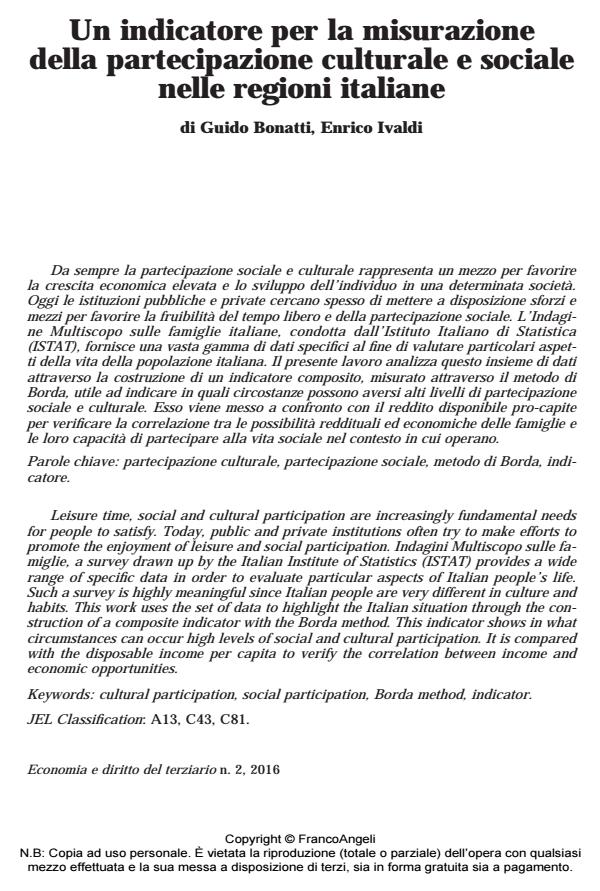Un indicatore per la misurazione della partecipazione culturale e sociale nelle regioni italiane
Titolo Rivista ECONOMIA E DIRITTO DEL TERZIARIO
Autori/Curatori Guido Bonatti, Enrico Ivaldi
Anno di pubblicazione 2016 Fascicolo 2016/2
Lingua Italiano Numero pagine 20 P. 283-302 Dimensione file 464 KB
DOI 10.3280/ED2016-002004
Il DOI è il codice a barre della proprietà intellettuale: per saperne di più
clicca qui
Qui sotto puoi vedere in anteprima la prima pagina di questo articolo.
Se questo articolo ti interessa, lo puoi acquistare (e scaricare in formato pdf) seguendo le facili indicazioni per acquistare il download credit. Acquista Download Credits per scaricare questo Articolo in formato PDF

FrancoAngeli è membro della Publishers International Linking Association, Inc (PILA)associazione indipendente e non profit per facilitare (attraverso i servizi tecnologici implementati da CrossRef.org) l’accesso degli studiosi ai contenuti digitali nelle pubblicazioni professionali e scientifiche
Da sempre la partecipazione sociale e culturale rappresenta un mezzo per favorire la crescita economica elevata e lo sviluppo dell’individuo in una determinata società. Oggi le istituzioni pubbliche e private cercano spesso di mettere a disposizione sforzi e mezzi per favorire la fruibilità del tempo libero e della partecipazione sociale. L’Indagine Multiscopo sulle famiglie italiane, condotta dall’Istituto Italiano di Statistica (ISTAT), fornisce una vasta gamma di dati specifici al fine di valutare particolari aspetti della vita della popolazione italiana. Il presente lavoro analizza questo insieme di dati attraverso la costruzione di un indicatore composito, misurato attraverso il metodo di Borda, utile ad indicare in quali circostanze possono aversi alti livelli di partecipazione sociale e culturale. Esso viene messo a confronto con il reddito disponibile pro-capite per verificare la correlazione tra le possibilità reddituali ed economiche delle famiglie e le loro capacità di partecipare alla vita sociale nel contesto in cui operano.
Parole chiave:Partecipazione culturale, partecipazione sociale, metodo di Borda, indicatore
Jel codes:A13, C43, C81
Guido Bonatti, Enrico Ivaldi, Un indicatore per la misurazione della partecipazione culturale e sociale nelle regioni italiane in "ECONOMIA E DIRITTO DEL TERZIARIO " 2/2016, pp 283-302, DOI: 10.3280/ED2016-002004